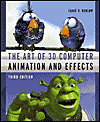 Oh man, is this book beautiful! Just browsing through the 500+ full-color images in The Art of 3D Computer Animation and Effects reminds me of why I entered the field of computer games and graphics in the first place.
Oh man, is this book beautiful! Just browsing through the 500+ full-color images in The Art of 3D Computer Animation and Effects reminds me of why I entered the field of computer games and graphics in the first place.
Author Isaac Kerlow evidently loves his work, and put a lot of that love and what he knows from his position, as Director of Digital Production at the Los Angeles offices of The Walt Disney Company, into this book. (Incidentally, the company where one of my computer graphics students also now holds a position.)
It’s rare that I’ll read a book cover-to-cover twice in the same week, but to absorb the amount of detail that is Art of 3D pretty much requires it. I also kept getting distracted by the pictures. Each page carries so much eye-candy and brain-candy it’s like reading through an encyclopedia. You go in looking for one thing and wind up reading about something completely unrelated. Okay, so I’m a graphics geek and I’m geeking out on this book. It’s the kind of book you simply must geek out too. Did I mention the pictures already? All of the information and techniques presented are accompanied by a copious number of full-color images covering the last 50 years of computer animation. Art of 3D introduces many of the concepts that were pioneered in the pre-digital days and brings them right up to date.
Art of 3D should ideally be read cover-to-cover, though each section stands alone and can be read in a single sitting. Much of the material is taught in a semi-tutorial style, remaining platform- and software-agnostic, but presented in a manner that lets you follow along whilst at your computer. There are only a few images from various software packages included to illustrate a particular point.
It’s quite obvious Kerlow is a visual thinker and a great believer in lists. There are lists of team breakdowns, lists of standard software packages, lists of light source types—lists for everything. He even illustrates his lists with images.
Each section opens with a summary of what will be covered, jumps right into deep end of the material with appropriate images and illustrations, and finally wraps up with a list of terminology and points covered. The list is presented as bullet points to aid you in remembering the key items that were covered. Many sections also wrap up with a “Getting Started” piece for readers who are not sure how to approach the subject.
I’ve worked with quite a few art directors and game designers (as well as other programmers) who are incredibly talented and competent in their fields, but can occasionally lack the terminology for basic things such as camera movement or types of lights, and it then falls to me to doodle very poor illustrations on a whiteboard to explain my idea visually. I’ll be referring to Art of 3D a lot more when attempting this, as the simple comic-book panels illustrate key points perfectly. It’s not often you see the concept of ray-tracing explained using a pig in a top hat, a gopher holding a beer, and a strangely drawn human holding a daiquiri with an umbrella in it. I possess an entire shelf of books on cinematography techniques, and few are as succinct or clearly illustrated as the section in Art of 3D, using a wide eyed pig holding a Martini glass to illustrate the use of differing lenses, or dangling from badly knotted string for the time-freeze (a.k.a. bullet-time) effect.
Art of 3D really covers a lot of ground for the approximately 450 pages—everything from planning, workflow, production and personnel, through modeling, texturing, and lighting, right up to rendering “hacks” that modern studios will adopt to make sure they render all of the frames within the time constraints of a production schedule.
Though Art of 3D is aimed primarily at beginning to intermediate computer graphic artists, I think that many designers, programmers, and seasoned artists could really learn a lot from this book. You would need to spend years practicing traditional animation, computer graphics, stage lighting, cinematography, and many other techniques to know even a quarter of what’s covered in this book. While Art of 3D doesn’t profess to be an encyclopedic treatment of all these subjects, it does manage to give a good grounding in the small amount of space available to each section. The techniques and terminology I teach on my DirectX graphics courses are covered in vivid detail and I’ll certainly be introducing this book as recommended reading. Expect to see the 4th Edition of this book in a few years time with all of the great visual effects that were pioneered in the Lord of the Rings trilogy.
This book review originally appeared April 20th, 2004 on Gamasutra, the official webzine of Game Developer Magazine that I write for regularly.
Buy this book from Amazon.com now!
ABOUT THE AUTHOR
Isaav V. Kerlow is Director of Digital Production at The Walt Disney Company in Los Angeles, California. He is also a longtime active member of SIGGRAPH and the Visual Effects Society.
VERDICT
The Art of 3D Computer Animation and Effects, 3rd Ed.
 Author: Isaac Kerlow
Author: Isaac Kerlow
Publisher: Wiley and Sons
ISBN: 0-471-43036-6
Pages: 451
Rating
10 out of 10
Pros
- Eye candy! Every technique is accompanied by images from games and movies that have implemented it.
- More eye candy! Each technical point is illustrated with appropriate diagrams.
- Covers almost every subject that applies to modern computer graphics.
Cons
- Could use a second volume to go further in-depth on many subjects.
- Eye candy! The beautiful pictures can distract you from your task.
- Only offers a broad overview of the subject matter.



